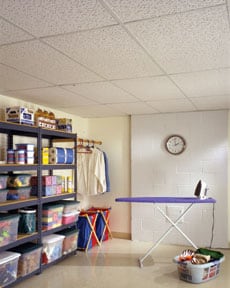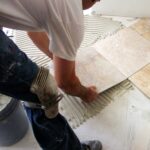Increasing Basement Ceiling Headroom
An expert DIY guide on converting a basement into a livable space. Provides tips for clearing the space, heating and cooling, increasing headroom, and more.
One of the most efficient ways to gain that extra space is to make your basement a livable area.
If your home has a dry basement with a ceiling that is at least 7 feet high, the chances are good you can convert the area into living space.
Quiet and distinctly separate from a home’s main living areas, basements are often ideal for recreation rooms, entertainment centers, workout rooms, home offices, and in-law living quarters. Many basements have reasonably good access from the rooms above, and many are large enough to afford space for several rooms.
Dryness is key to a successful basement room. If your basement is perennially damp or, worse, floods every winter, your first investment must be in controlling the water that invades it. Drains, foundation waterproofing systems, a sump pump, grading, and surface water diversion all are important means for achieving a dry basement.
Though there are certain things a handy homeowner can do to remedy a damp basement, handling basement water problems is often best left in the hands of a professional waterproofing contractor.
Dealing with mechanical equipment such as heating ducts, electrical conduit, and pipes is also an issue. If headroom allows, equipment sometimes can be concealed above a false ceiling. Otherwise, it may need to be rerouted. One other alternative is to leave ductwork and conduit exposed and paint these elements to blend into the decor.
Keep in mind that you’ll need to heat-and perhaps cool-the area, as well as provide it with good ventilation. And dehumidification will probably be a must.
Work with a heating contractor to determine what will be involved in extending the existing system to serve the basement. This is often a relatively easy job if the system is large enough to handle the increased load.
Because natural light is often minimal in a basement, be sure to plan for ample artificial lighting. Some basements have one or more walls that sit high enough above ground level to allow for installing short windows to allow in natural light.
For related helpful information, see Insulating a Concrete Slab Floor and Basement Moisture Control.
Increasing Basement Ceiling Headroom
Adding height to your basement ceiling for a conversion can be done, but it’s an expensive project.
Local codes specify the minimum height a ceiling must be-this is often 7 feet. If your home’s basement ceiling is lower than allowed, you may still be able to convert the basement, but you’ll add significantly to the expense, the labor, or both. It’s often cheaper and easier to get the extra space you need by adding on to your house.
One option for gaining basement ceiling height is to have your house lifted off of its foundation so that the foundation walls can be heightened. You can hire contractors who specialize in lifting and moving houses. This job is not to be taken lightly (no pun intended). When done properly, it’s costly and quite involved.
Another option is to excavate the basement floor. If you need only a few extra inches, this might be a reasonable option. But excavation is a major job, and it is critical that the foundation not be compromised in any way during the process. You will definitely need to consult with a professional. These links will take you to a free service that will help you find a structural engineer and/or a soils engineer—before considering this option, or a prescreened local basement remodeling contractor.








 Don Vandervort writes or edits every article at HomeTips. Don has:
Don Vandervort writes or edits every article at HomeTips. Don has:



